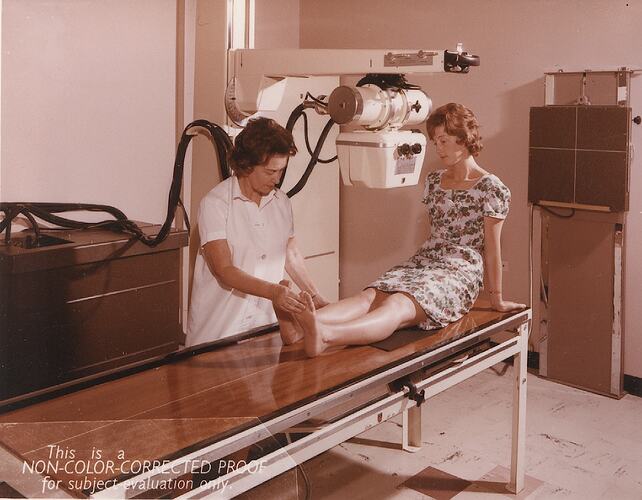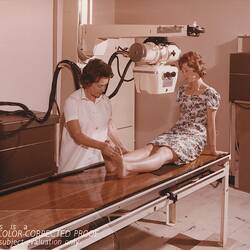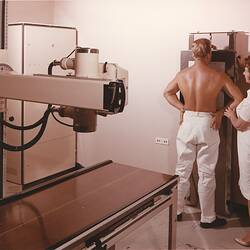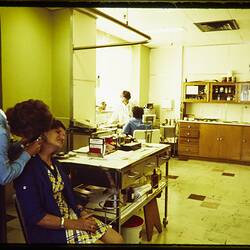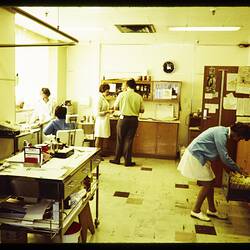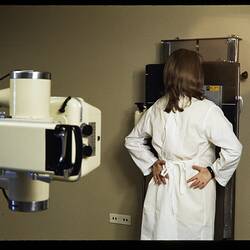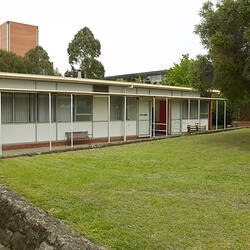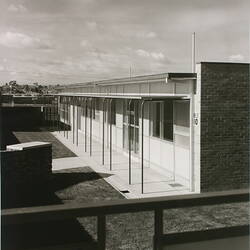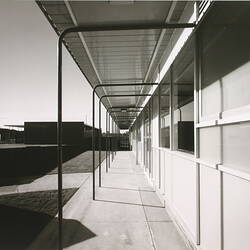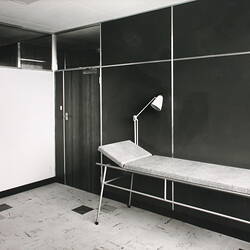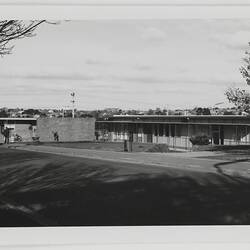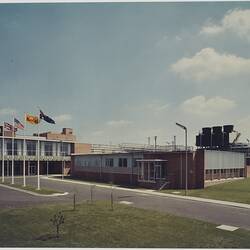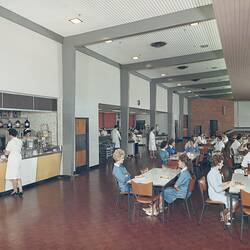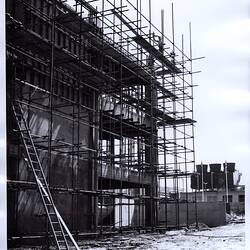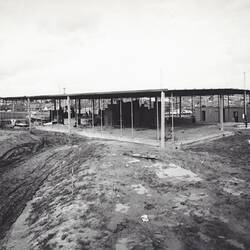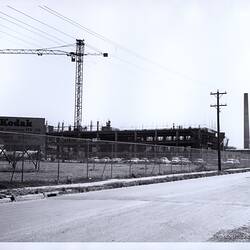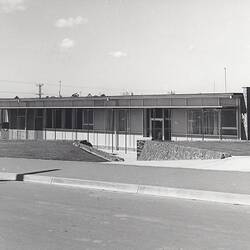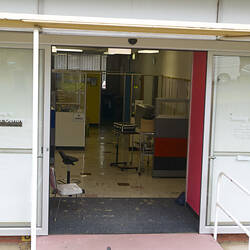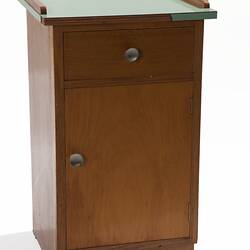An important and widely used benefit for Kodak Australasia staff was the provision of medical care onsite at its factory and other key locations.
George Eastman, founder of Kodak Australasia's parent company, Eastman Kodak, laid the foundations for Kodak onsite medical care in 1911. He established a safety committee at his Rochester USA factory at this time and one of the measures they suggested was the appointment of a physician to provided medical care in the event of injury. By 1914 this medical care had extended to the development of a Medical Division to provide care for staff who were 'ailing'.
Kodak Australasia Pty Ltd followed the example set by Eastman Kodak, possibly due to Thomas Baker's own background as a pharmacist and interest in medicine, and became one of the earliest companies in Australia to recognise the value of industrial medicine. Dr. Sydney Crawcour was appointed as the staff doctor and worked at Kodak's Abbotsford factory site from at least 1928 until he retired in 1959. He was considered one of the leading industrial medical officers in Australia.
Dr Crawcour had an office in the main factory building on Southampton Crescent and would attend there one or twice a week. Former employee Val Bell, nee Bullock, who worked at Kodak as a typist in the late 1930s and early 1940s, remembered that staff could consult Dr Crawcour if they were ill, and if the workers had been away sick "..we'd have to report to him when we got back, that sort of thing, he'd give us the okay". She also recalled that there was a sick bay for staff to use. As part of his duties Dr Crawcour sometimes assessed the health of new staff. For example, Thelma McGregor (later Sneazwell) attended Dr Crawcour's private South Yarra surgery prior to starting work at Kodak in 1939.
By 1945 the company had a 'fully equipped' medical centre, which was described as being one of the first of its kind in Australia. It had dressing, rest and waiting rooms; a consultancy room, and a surgery. Dr Crawcour attended the new centre every morning, while the centre was also staffed 'throughout the working hours' by a trained nurse. Staff were referred elsewhere for more specialised medical care where necessary. For instance, former Glass Plate Department worker John Garrett recalled that he was sent to the Eye and Ear Hospital in East Melbourne after getting glass in his eye in the 1930s or 40s.
When the company moved to new premises in Coburg, staff were provided with a modern and fully equipped medical centre housed in Building 10. The new medical centre was originally under the supervision of Dr. Arnold Cooper, who had succeeded Dr Crawcour in 1962. By 1972 the centre featured a full-time medical officer and nursing staff, physiotherapy facilities and an X-ray department. Chest X-rays and vaccinations against common illnesses, such as influenza, were also available to all employees. In oral history interviews conducted by Museums Victoria staff, former Kodak staff recall that the Coburg centre functioned as a general practice. One former staff member, Trish Lobb, recalls that she didn't even have her own doctor outside of work.
By 1968 a limited medical centre was also available at the Annandale factory site in Sydney. This centre was supervised by Sister Margaret Gale, an occupational health nurse provided to the company through funds provided by Australian government, although the centre seems to have still been managed by the medical officers at head office. Margaret recalls receiving advisory visits from the different doctors in charge of the Coburg medical centre and also taking part in events with other nursing staff from Coburg.
In the early 1970s Kodak's medical officer Dr. Cooper travelled to the United States of America for five weeks in order to view other Kodak run medical centres, and he reportedly returned with ideas for the improvement of the facility including the implementation of a program to assist staff with drug or alcohol dependency. Sadly, Dr. Cooper died of a sudden heart attack in March 1972, but the program was nontheless later implemented by the company. Dr. Cooper was succeeded by Dr. William (Bill) Granger who ran the Coburg facility for five years before he retired in 1977. Dr. V. Kaye Spowart then succeeded him as the new Medical Director in late 1977.
During Dr Spowart's term there were 6 staff working with him at the medical centre. In 1978 they included nursing sisters Pat McMillan and Joan Frenzel, and night shift sister Pat Humphries who worked 5.00 pm - 10.30 pm, radiographer Margaret Kan, physiotherapist Geoff Luke, who saw 70 patients a week, and medical secretary Penny Knott. A visiting opthamologist Dr Norman Mellor and a spectacle maker John Nock consulted monthly. In 1986 the Geoff Luke had retired and new physiotherapists Ian Christian and Greg Brewer were appointed.
Although the focus of the Coburg Medical Centre continued to be the health and well-being of Kodak staff, the centre's focus gradually began to move towards 'prevention rather than cure'. By the early 1990s the focus had shifted almost exclusively towards Occupational Health & Safety, following the trend of other Kodak medical centres worldwide. As a result, consultations for staff were only available in the mornings and the rest of the time was devoted by medical staff to occupational medicine and safety issues, with a particular focus on returning staff to work following an injury or illness.
Staff from the medical centre ran courses on manual handling and hearing conservation as well as monitoring the health of staff exposed to harmful substances. Possibly as a consequence of this change, Dr. Trevor Smith, who had succeeded Dr. Spowart, was both the Medical Director and the Manager of Corporate Occupational Health & Safety.
In 1993 Dr Smith's team included Raelene Williams, Chris Lydiate, Kaye Longman, Russell Bond and Ingrid King. Pat McMillan had retired from the position of senior sister at the Coburg Medical Centre in February 1992 after 25 years service.
In 1998 Mr Claus Dyck took over responsibility of all Kodak Health, Safety and Environmental activities in Australia and New Zealand. As the Manager of the Medical Centre, Health, Safety & Environment, Claus Dyck appears to have taken over the responsibilities of Dr. Smith, including oversight of the Medical Centre. Dr. Jane Wadsley joined the company, also in 1998, as Occupational Physician and appears to have reported to Mr. Dyck. Dr. Wadsley was assisted by two Occupational Nurses, Sister Sue Com and Sister Kay Lawrence, along with a Physiotherapist, Ms. N. Sparkes.
It is unclear how long the Medical Centre continued to run but it is likely that it continued until the early 2000s when operations at the site began to close down.
References
'Australian Kodakery', No 9, Apr 1969, p. 3 (HT 35708)
'Australian Kodakery', No 26, Jun 1971, p. 2 (HT 35725)
'Australian Kodakery', No 34, Apr 1972, p. 2 (HT 35744)
'Australian Kodakery', No 38, Aug 1972, p. 3 (HT 35748)
'Australian Kodakery', No 81, Aug 1977, p. 3 (HT 35799)
'Australian Kodakery', No 83, Oct-Nov 1977, p. 1 (HT 35801)
'Australian Kodakery', No 91, Jun 1978, p. 4 (HT 35933)
Booklet - 'Around the Old 'Yarra Grange' Homestead...', Kodak Australasia Pty Ltd, Staff Booklet, Sales Division, Abbotsford, Victoria, Jan 1948, pp. 38-9 (HT 30096)
Booklet - Eastman Kodak Company, 'Eastman Kodak Company, A Brief History', Rochester, p. 11 (HT 30114)
Bundle, Nancy & Kitay, Jim, Nurses At Work: A History Of Industrial And Occupational Health Nurses In New South Wales, Waterloo, New South Wales: NSW Nurses and Midwives' Association, 2017, p.124
Interview - Trish Lobb, 6 June 2012 (HT 33851)
Interview - John Garrett, 1 May 2014 (HT 37042)
Interview - Noel Monteith, 20 May 2014 (HT 37135)
Interview - Val Bell, 26 June 2012, (HT 33858)
Interview - Thelma McGregor, 12 October 2012, (HT33838)
'Kodak News', No 181, Aug-Sep 1986, p. 10 (HT 36025)
'Kodak News', No 217, Issue One, Jan-Feb 1993, p. 10 (HT 36095)
'Kodak News', No 219, Issue Three, May-Jun 1993, p. 12 (HT 36097)
More Information
-
Keywords
-
Authors
-
Article types
